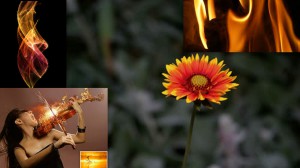The general premise of the pair of murals in the University of Oregon Knight Library is certainly relevant. They are indeed interpretations of the development of the arts and sciences, and what better place than a public college campus with an emphasis in liberal arts to display such public murals?
In terms of civic beautification and relevance, these murals maintain an important role – and perhaps this role is important merely because to have art in a public place is significant. To be honest, I did not even know these murals existed before it was called to my attention to observe them. My initial reaction was that it was really cool to have historic art in the library. Actually, the library hosts quite a diverse demographic of students – it is probably a bit of a generalization to say this, but I think every University student has gone to the library at least once.
I believe it is within the issue of diversity that these murals present a conflict of interest and ideals. When I studied the murals more closely, a few things came to my attention. First of all, in the mural of the Development of the Sciences, I couldn’t find any figures representing women. We all know (or at least we should) that women have in fact contributed immensely to many fields of the sciences, and to exclude them completely from a depiction of the historic development of the sciences is, as one could imagine, wildly offensive merely because of its omission. Being a school with a multitude of Science Colleges, all of which include women, the presence of this mural is rather contradictory, and one could argue its relevance. According to Doss, “today’s public art diversity speaks to America’s diversity – and to the increasing number of Americans who want to see their cultural interests represented in the public sphere.” (Doss, 2)
This mural is controversial because it represents a lack of diversity, which should certainly spark a feminist debate, if it hasn’t already. Public art and “public art discourse, like all conversations, can lead to a larger examination and questioning of assumptions, ideas, and concepts.” (Doss, 6)
I feel slightly conflicted in this situation. The art didn’t specifically offend me, at least not intensely. Don’t get me wrong, the purposeful exclusion of women in a historical depiction of the development of the sciences pisses me off; it is untruthful and unfair. However, at the time when this mural was created, such exclusions were normal and expected. Does that make it acceptable? No, of course not, but does that necessarily mean that the mural should be taken down or replaced? I don’t think so.
This public art does prompt civic discourse about the issue of diversity, but neither mural represents positive depictions of gender equality or ethnic or racial diversity. So if they do not represent positive depictions, are they effective means of communication. One the one hand, “public art often has to cater to multiple constituencies and, as any politician knows, you can’t please everyone.” (Doss, 10) But on the other, the murals really do not seem to represent the values of the University, at least not the values of diversity it claims to advocate.
Debates regardless, I think the value of public art is incredibly important. As we’ve come to realize throughout this course, arguably all mediums of art serve a communicative purpose to whatever audience it may speak to. The capacity and profundity of public art, it seems, is that it has the potential to reach a much wider and diverse audience than some mediums. The concept of “placemaking” that centers on public art is something that I feel ties importance, relevance, and controversy altogether. In the theory of placemaking, “public art is seen as a solution to the problem of placelessness, especially in its ability to remedy social alienation and generate a sense of civic and community identity.” (Doss, 5) It is the sense of social connectedness, the ability of public art to inspire, at times, intense community and civic discourse, that matters; it shows in a rather raw way, the value of art, the capacity art has as a way of communicating with each other, especially about extremely charged topics.

